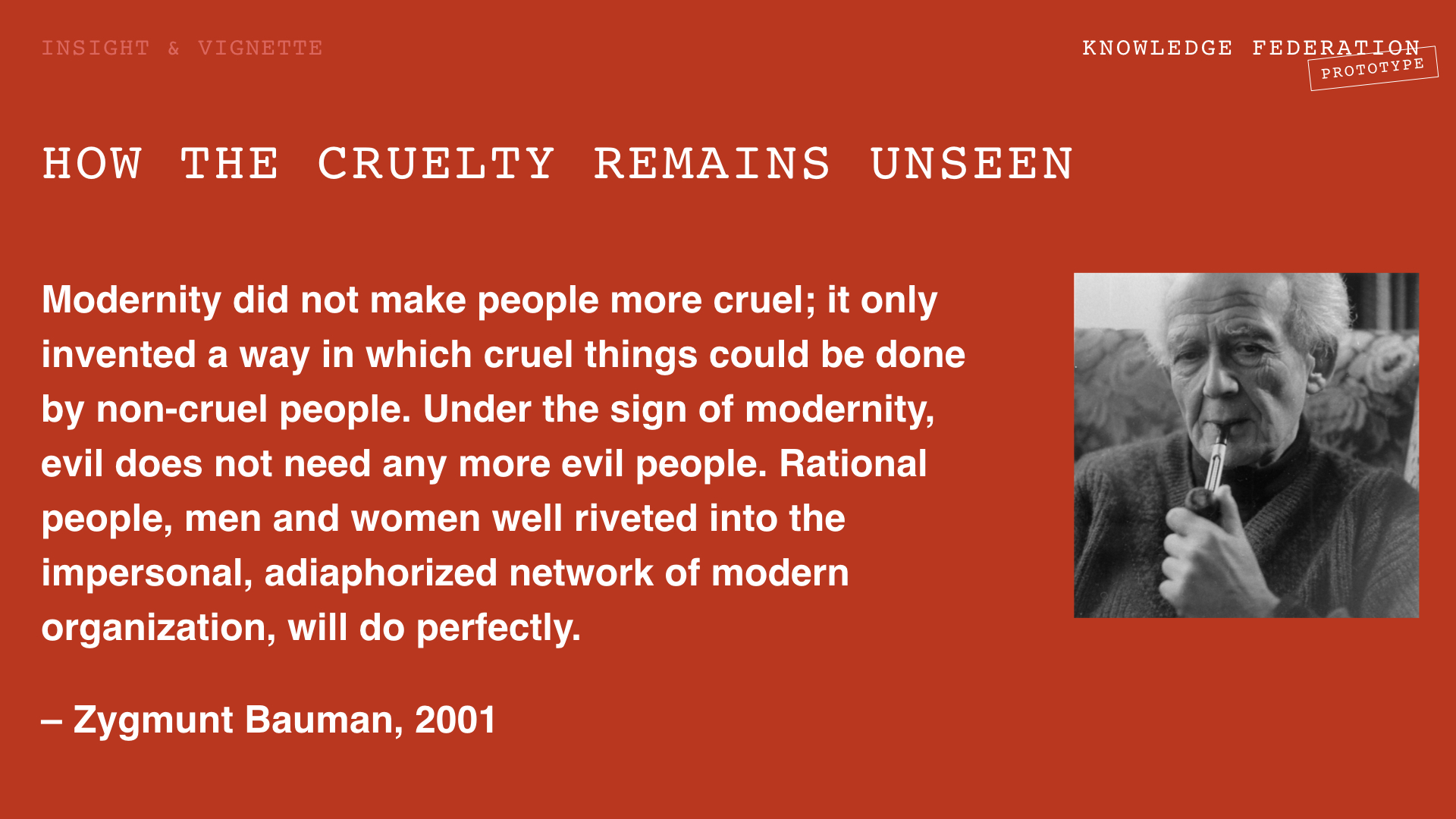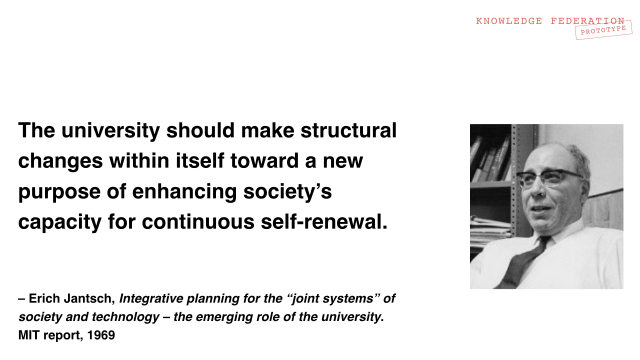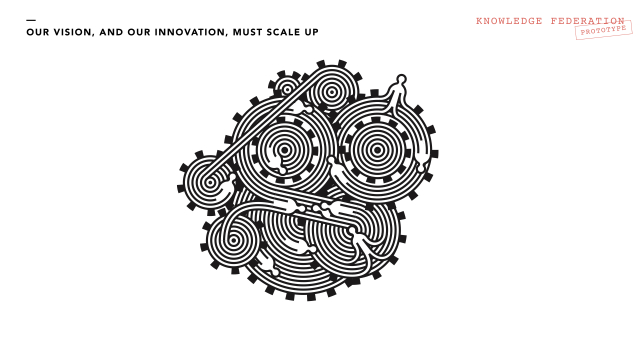Holotopia: Power structure
Contents
- 1 H O L O T O P I A: F I V E I N S I G H T S
- 2 Power structure
- 2.1 Stories
- 2.2 Wastefulness of our systems
- 2.3 Devolution of our systems
- 2.4 The root of evil
- 2.5 What needs to be done
- 2.6 Ideogram
- 2.7 Keywords
- 2.8 Power structure
- 2.9 Systemic innovation
- 2.10 Prototypes
- 2.11 Knowledge Federation transdiscipline
- 2.12 Healthcare as a Power Structure
- 2.13 The Game-Changing Game
- 2.14 The Club of Zagreb
- 2.15 Authentic Travel
- 2.16 Collaborology
H O L O T O P I A: F I V E I N S I G H T S
Power structure
At the turn of the 20th century, it appeared that the technology would liberate us from drudgery and toil, and empower us to engage in finer human pursuits, such as human development. But we appear to be just as busy and stressed as people ever were! What happened with all the time we've saved?
We look at the systems in which we live and work. Imagine them as gigantic machines, comprising people and technology, whose function is to take our daily work as input, and turn it into socially useful effects. If we are stressed and busy—should we not see if they might be wasting our time? And if the result of our best efforts are problems rather than solutions—should we not see whether they might be causing those problems?
The question must be asked, Why, indeed, are we so prodigiously successful in creating miniature gadgets that we can keep in our pocket—and completely neglecting those large and incomparably more important ones? Why don't we adapt them too to the purposes that need to served? As the common sense, and the Modernity ideogram demand.
The reason is that they serve for us an entirely different purpose: They organize us effectively against each other; they give us a better chance in our various turf strifes, and power struggles.
Stories
Wastefulness of our systems
We may have all the resources we need to take care of the world's largest problems. The roots of those problems are in the systems in which we live and work, which determine in what ways those resources are being used. The Ferguson–McCandless–Fuller thread is intended to serve as a parable, pointing to the wastefulness of some of our core systems (finance, and governance tainted by "special interests"). See it outlined here and here.
Devolution of our systems
An even deeper, or even more pivotal issues, is the manner in which the systems in which we live and work evolve. "The survival of the fittest", we seem to believe, will take care of that. But will it, really?
The insight we need from the studies of Darwinian evolution is that it favors (as Richard Dawkins pointed out) the best adapted gene; or meme—when we apply it to understanding social and cultural evolution.
The Chomsky–Harari–Graeber thread is also intended to serve as a parable, pointing to a sobering conclusion that this sort of study leads us to: The social-systemic "survival of the fittest" will tend to favor aggressive systems, that are damaging to culture, and to ourselves. Wee it outlined here. Make sure to process also our commentary of Joel Bakan's "The Corporation", which shows that while the results of this systemic devolution may look different in modernity, the pathological nature of its outcome has remain unchanged.
The root of evil
Zygmunt Bauman's observations about how the nature of evil and cruelty changed in modernity is of our central interest. Even the Holocaust, Bauman observed, may be seen as a metaphor for (what we are calling) power structure—where even the worst nightmare can be the result of no more than everyone doing "his job".
The movie "The Reader" is an interesting elaboration and confirmation of Bauman's observations, "in popular culture". Perhaps even more interesting is the fact that this most central aspect of this film remained virtually unnoticed by critics. Kate Winslet, in her Academy Award winning role, portrays a person who became part of something horrid because it was "her job", because otherwise "there would be chaos". As this movie vividly puts forth, when the power structure changes, and the horror of the old one is seen in the light of day—we wake up from a dream, and begin to look for a scapegoat.
By doing that, they fail to receive an insight about our social psychology, which is one of the keys to resolving our contemporary entanglement.
It is not difficult to anticipate a similar kind of awakening—from the neoliberalist dream, the unreserved faith in free competition as a means to increase productivity and growth, which has fueled so much pathological growth and behavior not only in governance and business, but also in academia.
What needs to be done
We let Erich Jantsch voice our main point; we are, indeed, only echoing the call to action he issued a half-century ago.
Having delivered the opening keynote at the inauguration meeting of The Club of Rome, in 1968 in Rome, Jantsch was well aware that a capability we as society are lacking—to update or re-create the systems in which we live and work—would be the key to solutions. Immediately, Jantsch undertook to do what was obviously needed (see it outlined here).
Jantsch also served as an active link between two insights and lines of interest—represented in the holotopia prototype by Norbert Wiener and cybernetics, and by Aurelio Peccei and The Club of Rome—namely that to be able to "change course", our society eeds "headlights and steering" (see a brief summary here.
Ideogram
The System ideogram suggests that our institutions or more generally (socio-technical) systems, or the power structures, need to be perceived as gigantic mechanisms; and also handled accordingly (adapted to their purpose).
The ideogram also suggests that the power structures form an environment by which our life quality is determined, and in which our human quality grows or decays.
Keywords
Power structure
Every genuine revolution—and our proposed revolution in knowledge and awareness is not an exception—is also a revolution of the way in which power relationships, or "justice", are perceived and handled. We coined this keyword to point out where the next such revolution may be coming from.
To fully understand the power structure concept, all five insights and some reflection will be necessary. But to begin with, consider the power structure as modeling the intuitive notions "power holder" and "political enemy" in a new way. While our ethical, legal and political sensibilities are tuned to power structures of the times gone by, completely new ones are now obstructing our freedom, threatening our future, and demanding attention.
The power structure may be understood as social-systemic cancer—a 'malignant' growth of otherwise normal and necessary societal 'tissues', which saps the 'organism's' vitality and majorly disrupts its wholeness.
Within the context of our holoscope prototype, the power structure definition has often served as a way to argue that the proposed approach to knowledge is a necessary element of our 'societal immune system', because without it we cannot even see 'the enemy'. See the blog post Holoscope for the Buckminster Fuller Challenge, where the history of the power structure definition with links is provided at the end. Have a look at the video teaser at the very beginning. The entire blog post we wrote when it turned out that, in spite of personal contacts with some of the BFC leaders, which led to our application, even this progressive group was unable to envision that innovation was needed not only in "green" technology, but also and indeed above all in socio–technology; which is of course what our proposal was about.
Systemic innovation
We adopted this keyword, systemic innovation, from Erich Jantsch. He used it to point to the capability we are lacking, to become able to handle any of the large contemporary issues. Systemic innovation can be interpreted in two ways: As "making things whole", and as innovation on the scale of basic socio-technical systems. Both are needed to counteract the power structure devolution. See it outlined in our contribution "Enabling Social-Systemic Transformations" to "Transformation in a Changing Climate" academic conference.
Prototypes
Knowledge Federation transdiscipline
The Knowledge Federation transdiscipline may be seen as an initial prototype of what Erich Jantsch was calling for—an academic institution that is capable of federating information into systems. The method is simple: We create a systemic prototype, and organize a transdiscipline around it to update it continuously. The Knowledge Federation initiates or bootstraps this approach by creating itself as a prototype.
This self-organization was initiated at Knowledge Federation's second biennial workshop in Dubrovnik in 2010, and announced publicly at our first international workshop, within the Triple Helix IX International Conference at Stanford University, in 2011. See the blog report with link to article here.
Healthcare as a Power Structure
Maintenance—as a rule of thumb and orientation—is so much more effective and so less costly than repair; why isn't our healthcare conceived accordingly?
Could even healthcare develop 'cancer'?
The "Healthcare as a Power Structure" model, which was part of our collaboration with Prof. Gunnar Tellnes who was then the President of the European Public Health Association, was an example, both of an application of the power structure theory, and our intervention in a real-life academic system. We proposed our methodology (polyscopy) to the European Association for the History of Health and Medicine as a way to extend their traditionally historiographic work by developing "laws of change" results. See the abstract.
The Game-Changing Game
Here is what we, as a human generation, need to make our first priority: To empower the coming generation to see and disarm the power structure. And in that way become capable of crafting their future. To update the systems in which we live and work. The Game-Changing Game was a system in which elders in power positions, called "Z-players", empower the younger (in life and career phase) "A-players" to "play their life and career games" by changing systems, instead of conforming to the existing ones. Hence The Game-Changing Game is a generic system for changing systems. See our brief outline, with links, here.
The Club of Zagreb
The Club of Rome needs an update: Instead of trying to inform and convince people in power positions (whose very power comes from the power structure), The Club's members need to use their influence to empower the young ones to change the power structure. In 2012 we created The Club of Zagreb as prototype of such an update. See it described here.
Authentic Travel
All our prototypes can be seen as examples of systemic innovation in specific domains of application. We make systems or things whole by (1) identifying the changes that need to be made, (2) developing ways to do that, and (3) weaving the resulting design patterns together into a coherent prototype.
The Authentic Travel is a series of prototypes we developed for travel or tourism, which show how a redesign of the conventional corporate model may empower small economies and cultures, stimulate cultural exchange and post-war revitalization, and promote authenticity. A summary is provided here.
Collaborology
Education, as our society's "reproduction system", is of course a natural way to intervene into social-systemic evolution. Can education ceases being a preparation to join the power structure, and become an instrument of human development? See our educational prototype here.



